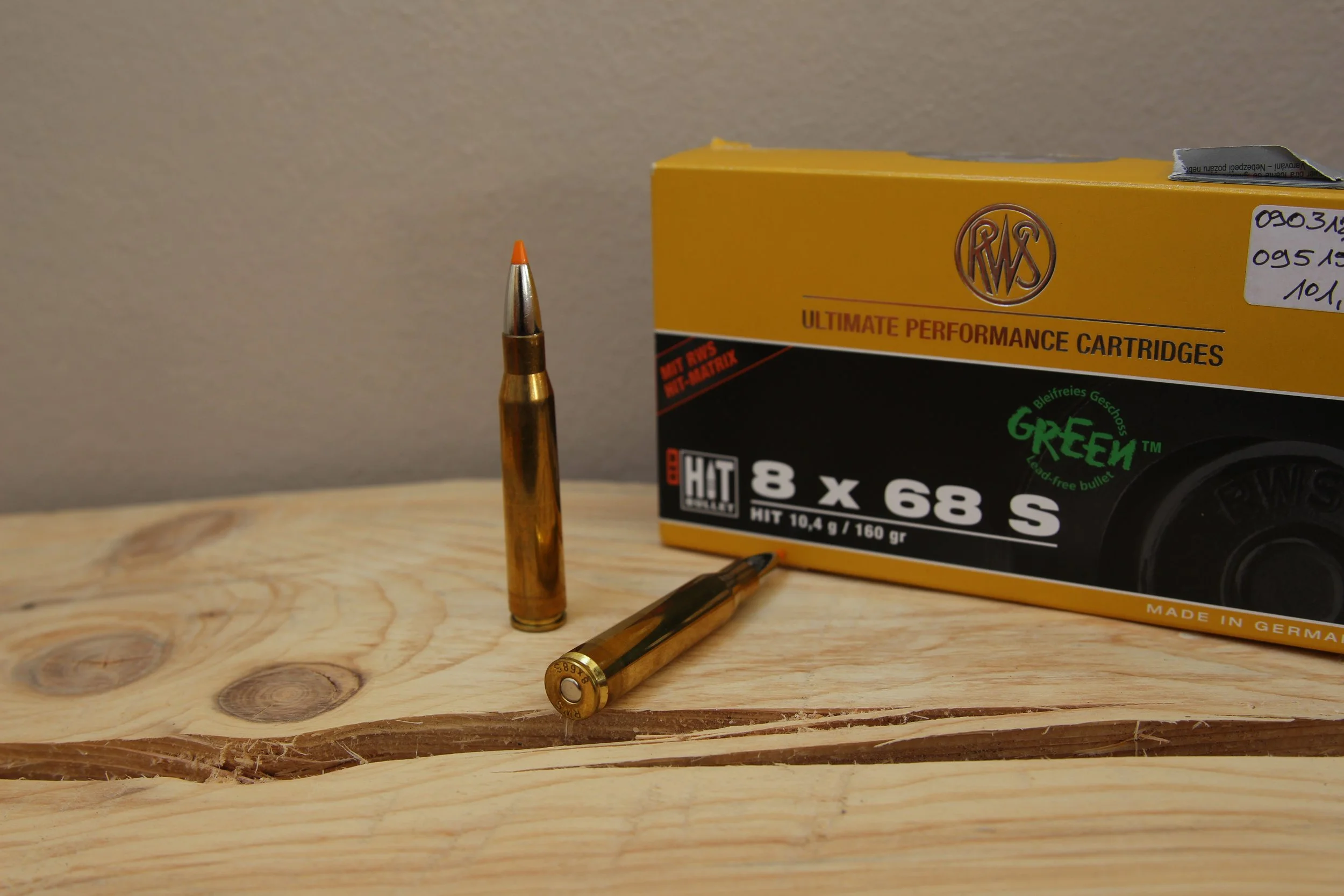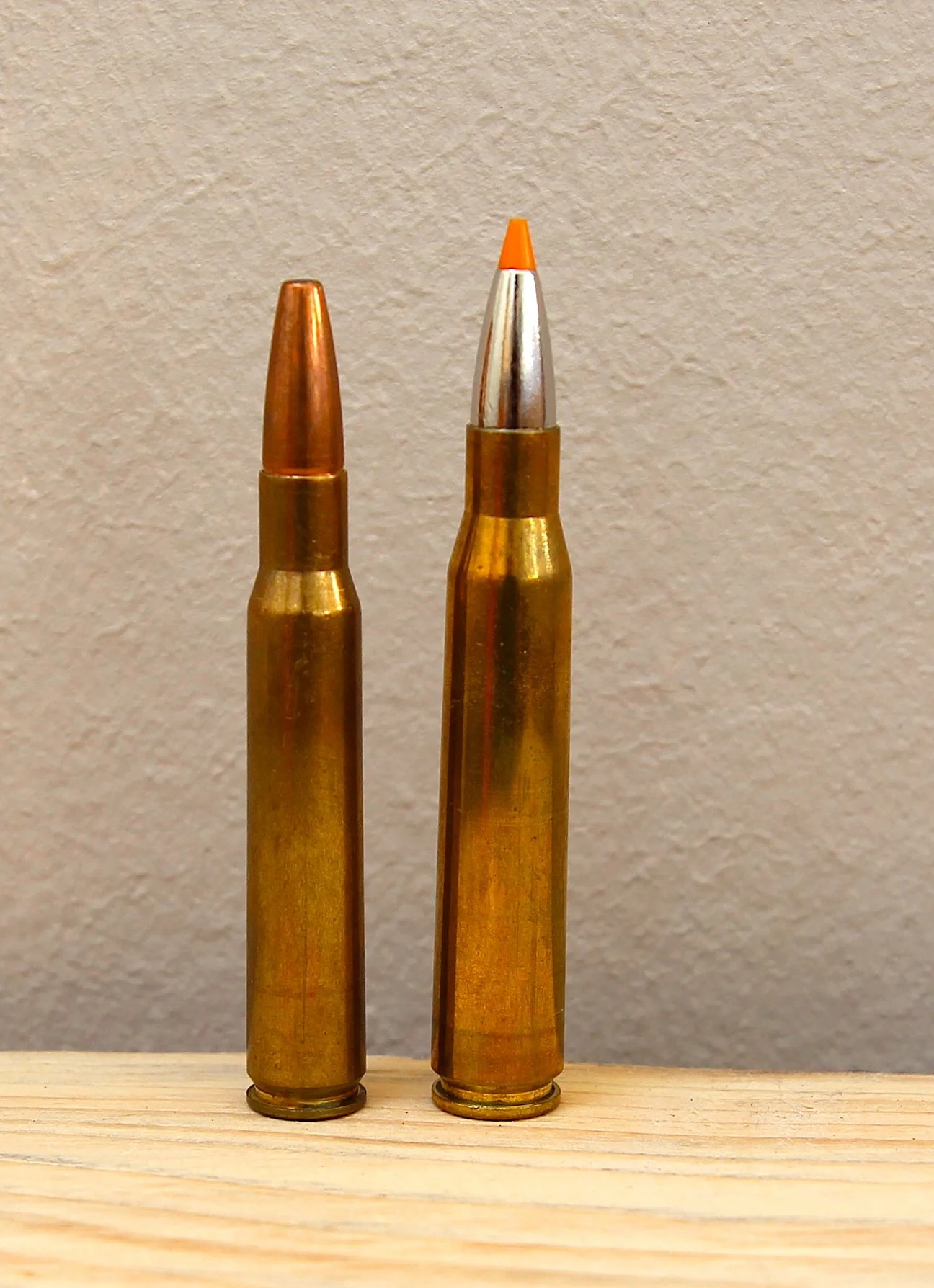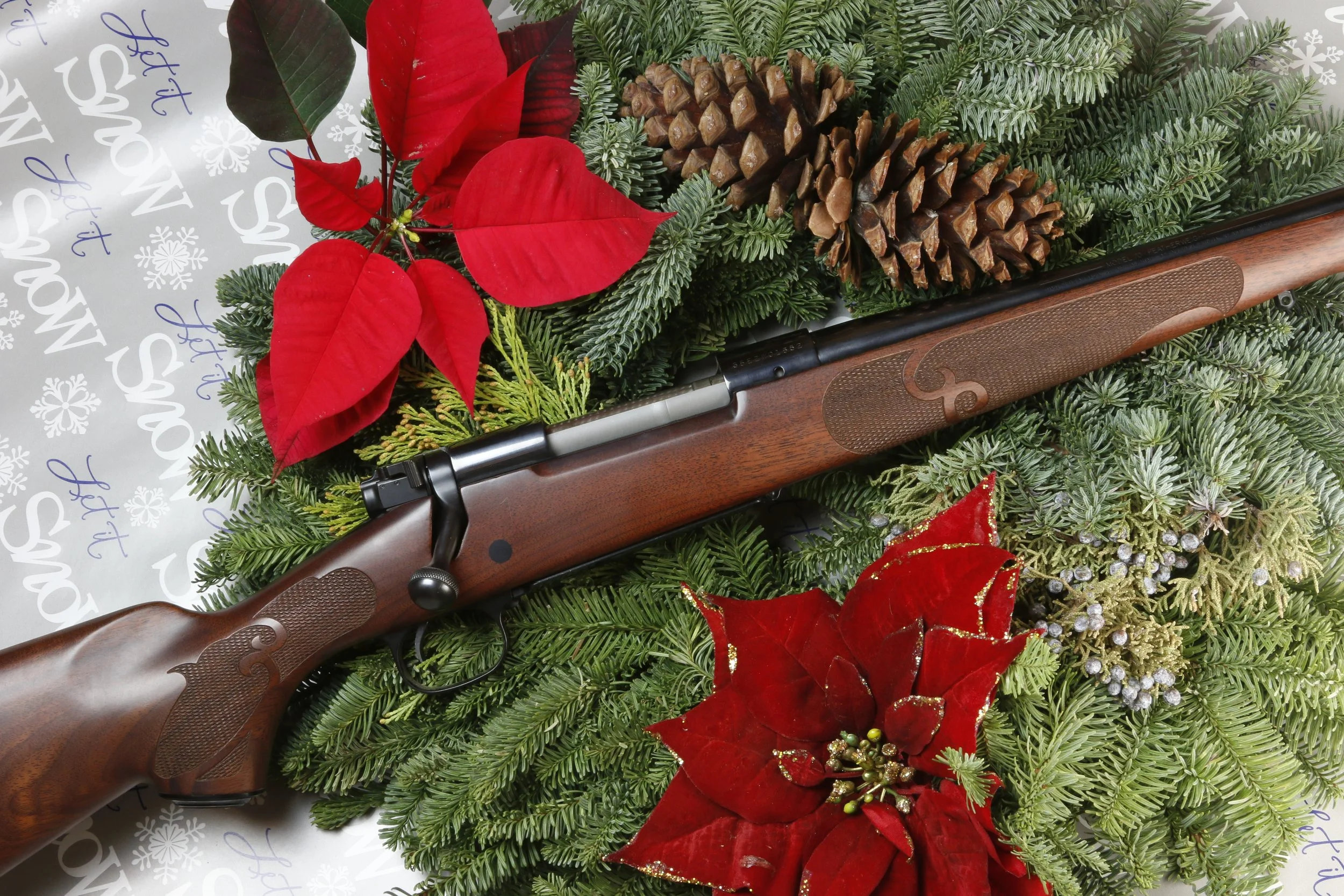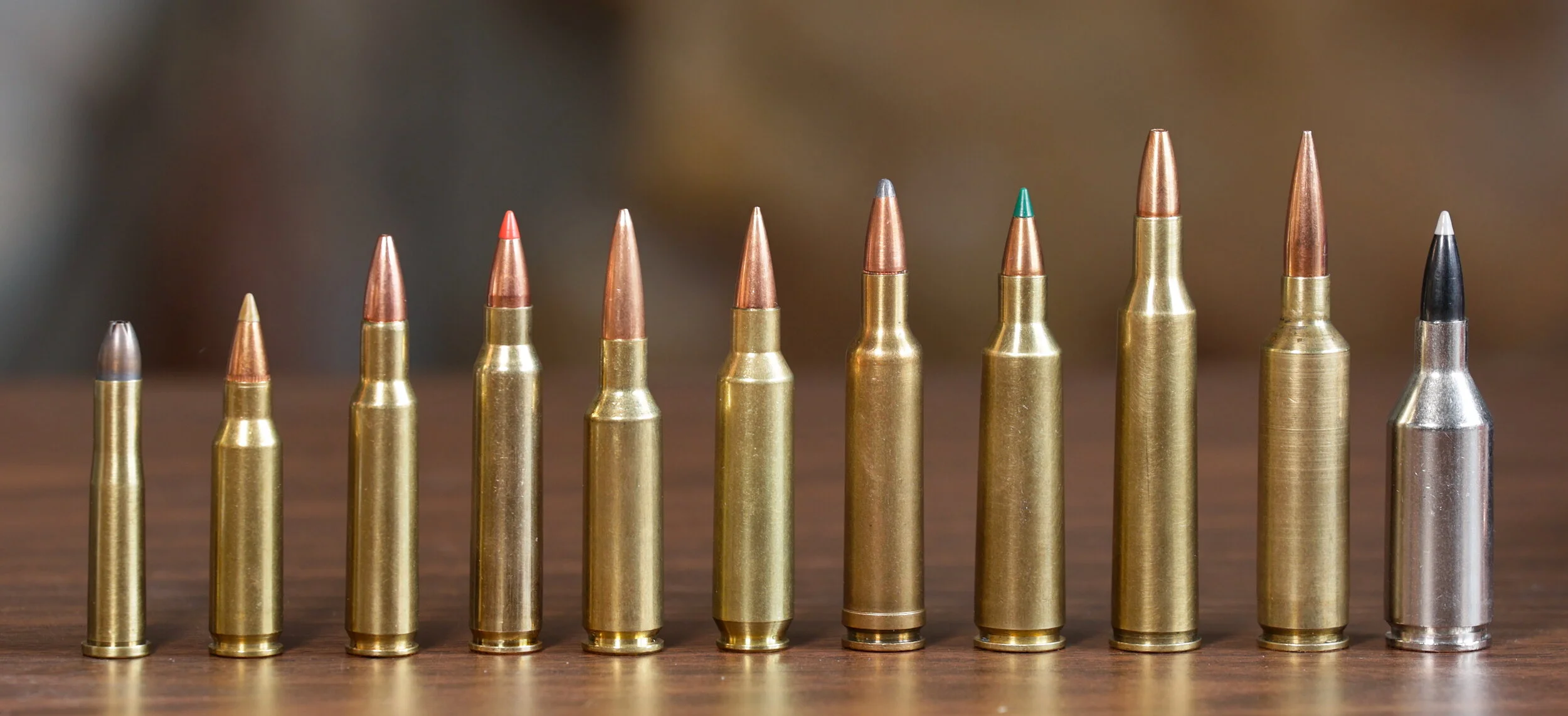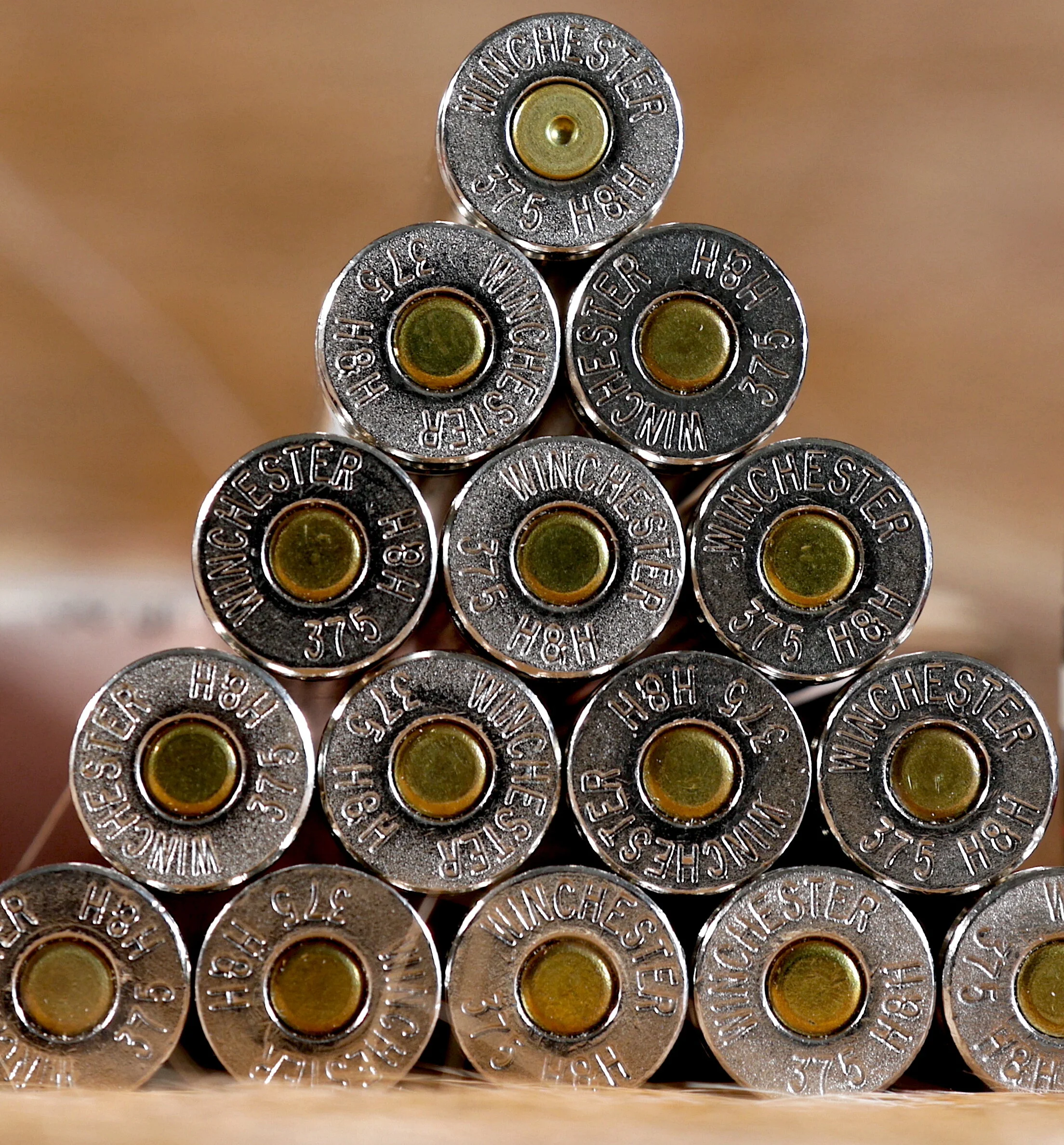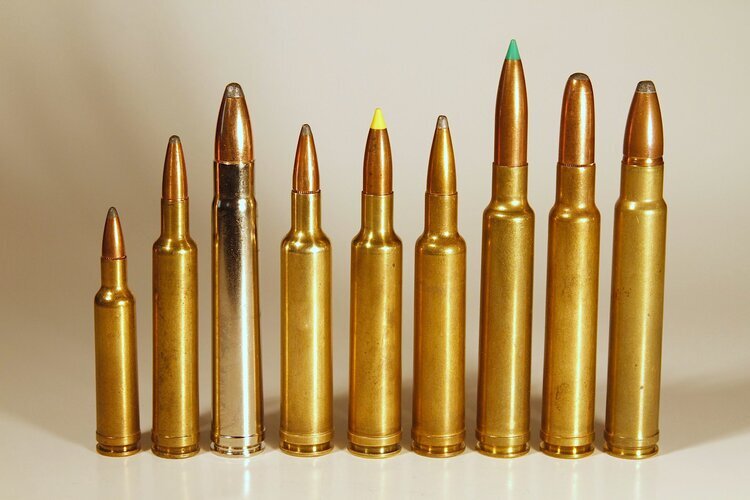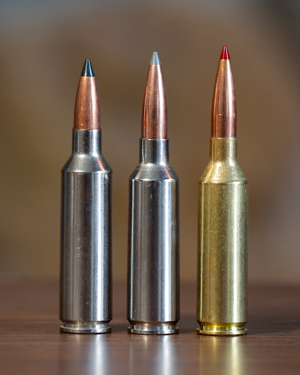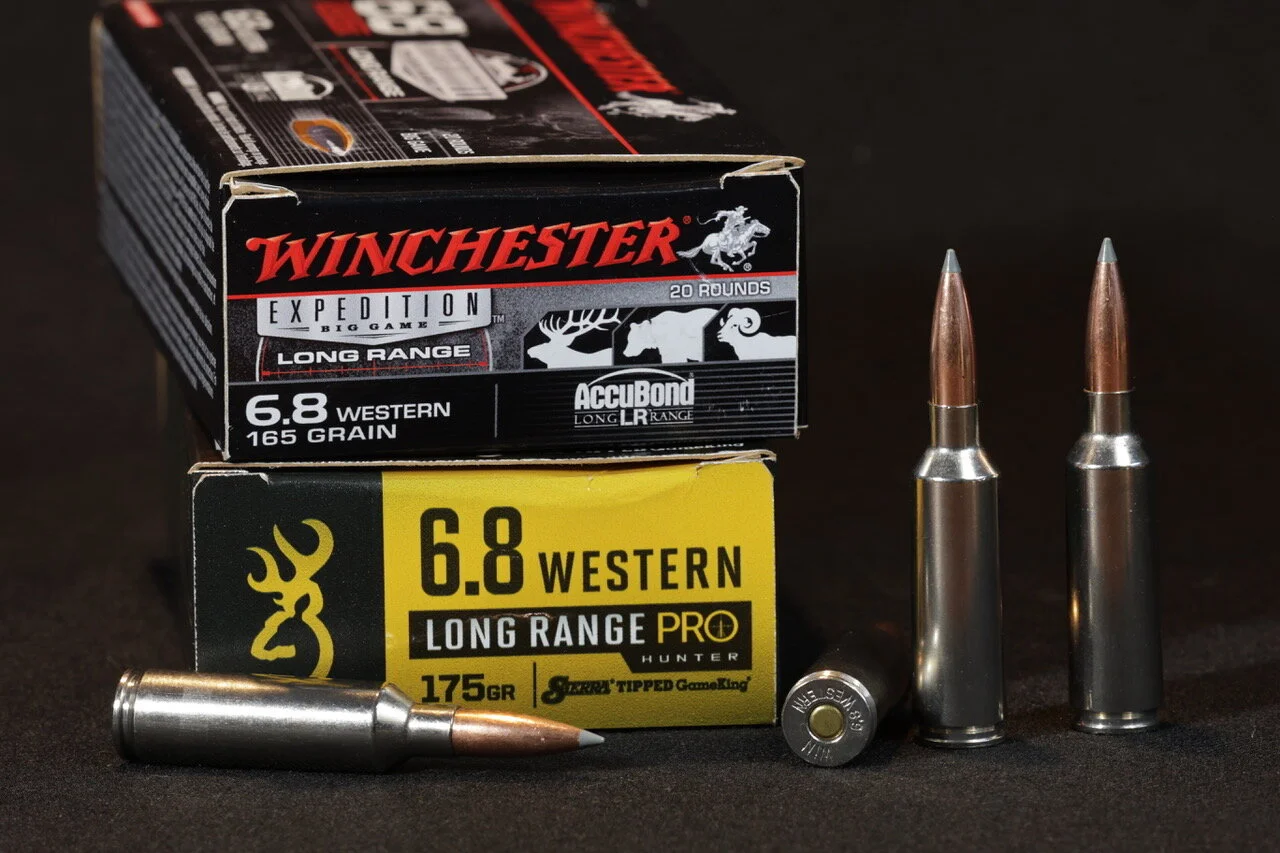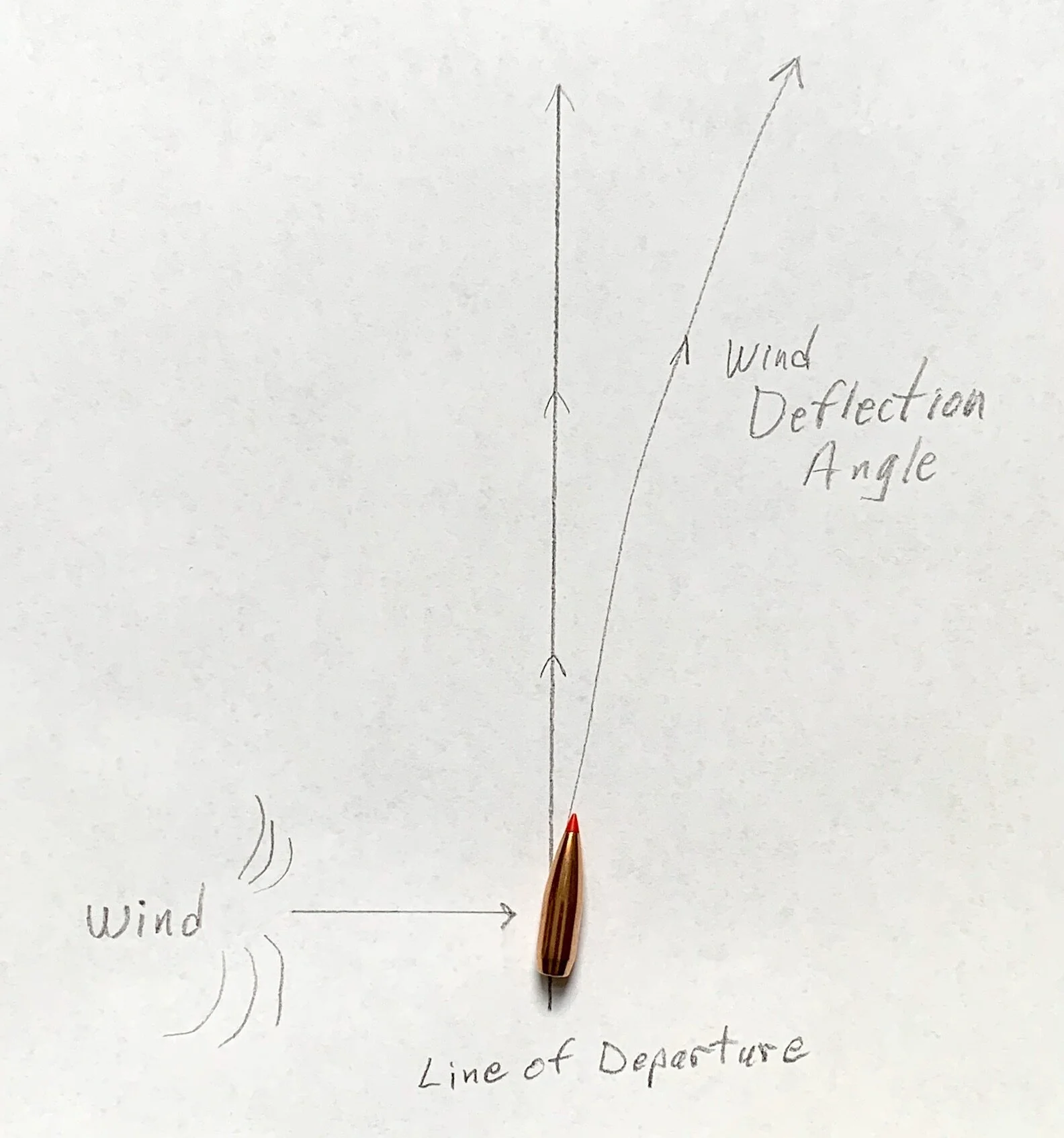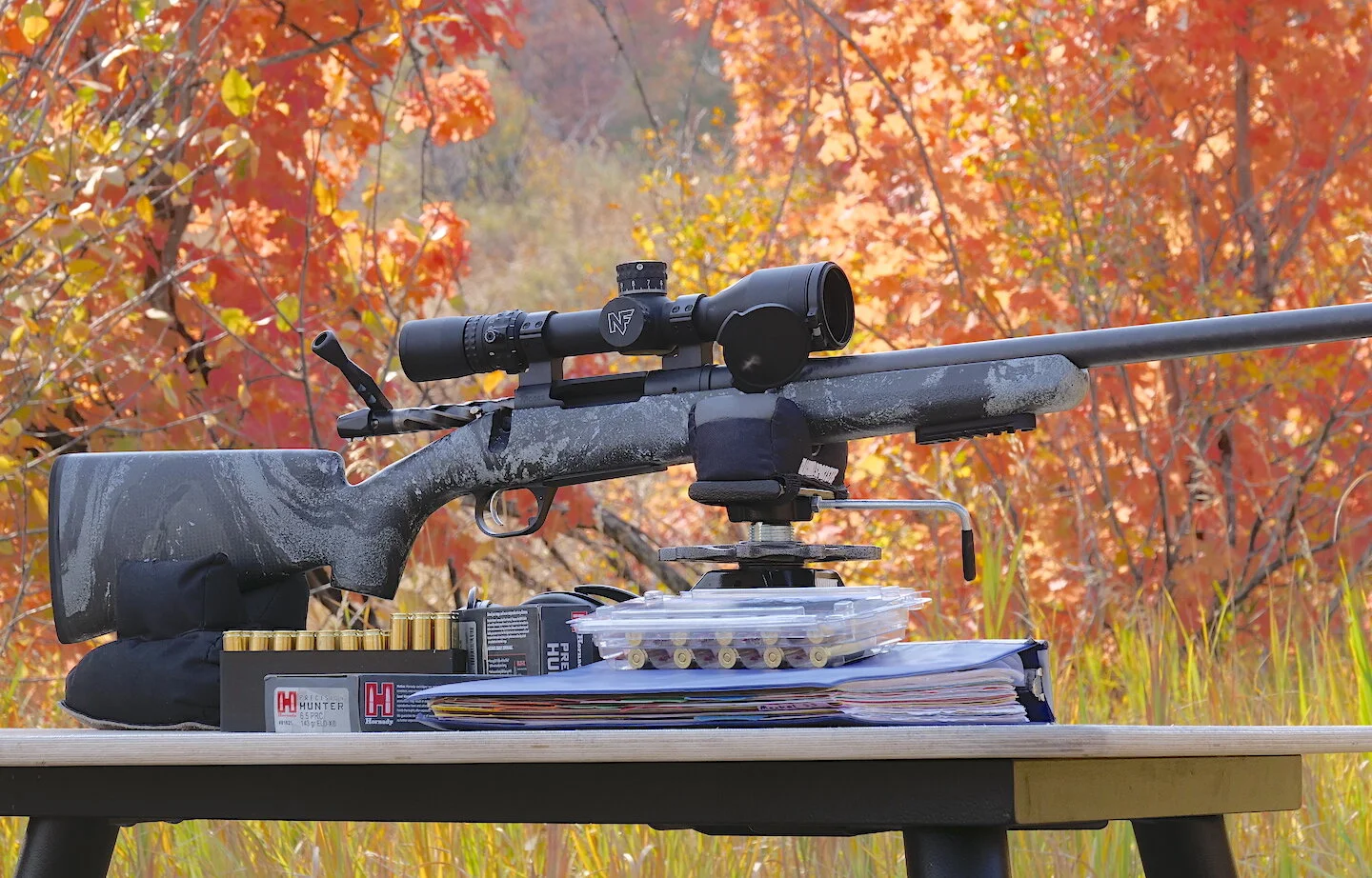The Two German Sisters
At the end of the 1930s, the german manufacturer RWS introduced a pair of high-performance cartridges to the hunting world. Designed from scratch to work in the venerable Mauser 98 standard length action, 6.5mm (.264 inch) and 8mm (.323 inch) bullets were housed in an entirely new, 68mm long case. The Father of the cartridges was August Schüler, a renowned gunsmith from Germany.
The beltless cases are identical for both cartridges except for the smaller bullets that sit atop 6.5x68mm. A slightly rebated rim made it easier to adapt the bolt head to accept a considerably thicker cartridge than the 8x57mm Mauser, which was the standard cartridge for the Mauser rifles. The bigger and longer case shows a flat angled shoulder for reliable feeding even in extreme hunting situations. The brass walls are relatively thick in both cartridges, which allows for “only” 86 grains of water for both sisters. Still, there is a lot room for powder, making both cartridges two of the faster and stronger in their classes. Both pills use the dimensions of the Mauser system to the fullest.
World War II prohibited early success in Central Europe, but after German hunters were once again allowed to own and hunt with centerfire rifles, both cartridges saw a growing group of followers. The high-performance level of both cartridges made each popular for a wide variety of hunting scenarios. The 6.5mm found a home in the European Alps, whereas the 8mm cemented its place in Africa due to its excellent performance on large antelopes and even buffalo.
As usual, when talking about siblings, the two share a few similarities. But both want and need a more individual look. So let’s have a look at both chamberings and see where they both excel.
Bigger bore: the 8x68S
The “German 8mm Magnum“ sends .323 inch diameter bullets down 24-26 inch barrels. This is the same “S-bore” diameter the 8x57mm Mauser cartridge uses since its modifications from 1905 when it was increased from .318 to .323 inches. The 8x68S was designed for the Mauser 98 bolt action rifle. By maintaining the same .323-inch bullet, adapting the new cartridge to the standard system was made easier. Because the 8x68 shoots heavier bullets flatter and farther than the 8x57mm, we can consider it a kind of magnum 8mm. If this doesn’t sound appealing to you, I don’t know what will.
Sure enough, hunters saw the advantage this cartridge offered. After the war ended, it became a darling of European red deer hunters and those who traveled the world for adventure hunts. It hits hard enough for any ungulate on this planet, although it’s light for Black Death and not legal in most African jurisdictions (it is legal in Namibia if loaded to 5,400 Joule muzzle energy, which is about 3,980 ft-lbs). It shoots flat enough and maintains enough energy at all sane hunting distances. Even pachyderms fall to it, though the 8x68S is far from ideal for that sort of hunting. And even though there might be better tools for bison and the really big bears of the north, both can be safely and humanely taken with the heavier and tougher bullets. Moose will fall to the 8x68S without a doubt, too.
In North America, I see the 8x68S as a perfect fit for elk country. A .323-inch bullet, ranging in weight from 150-220 grains in factory loads, sent towards these big and tough critters is a recipe for success. A well-known outdoor writer with a Weatherby Award to his resume calls the 8mm Remington Magnum his favorite elk cartridge, and he does so for a good reason. Well, the German 8mm Magnum is almost as powerful as the magnum-length Remington.
The 30-06 on left stands as testament to the “magnum” size of the German 8x68S.
One drawback to the 8x68S is the smaller selection of factory loads when compared to those for various .308 and .338 cartridges. Still, RWS, Blaser, Norma, and Brenneke offer a selection of different loads, bullets ranging from 125 grains to 220 grains. Premium manufacturers offer everything from heavy lead bullets to monolithic copper alloy bullets. Handloaders enjoy a proper selection for everything from light big game to real heavyweights like bison or moose. Maybe that is why the 8x68S has long been popular among handloaders. It is easy to load for accuracy and maximum performance, too. Bullets weighing around 200 grains usually give the best blend of weight and speed, thus the highest impact energy.
Recoil is stout but manageable for most. A good-fitting rifle goes a long way towards mitigating recoil. If using an ultra-lightweight setup for mountain hunting, a muzzle break can soften the kick. A lot of European rifles built for the 8x68S are on the heavier side, with bigger and heavier scopes giving additional weight. The longer barrels, necessary for complete powder burn, also reduce muzzle blast and felt recoil. Fired from a setup like that, I find the cartridge to recoil about the same as or just a little more than a .30-06 Springfield. That is not too bad for a cartridge that comfortably sits between the .300 Magnums and the .338s.
200-grain Nosler Partitions shoot accurately from the author’s 8x68S.
Ballistically, the 8x68S’ closest comparison is the .325 Winchester Short Magnum. The two are so close in trajectory, energy, and effectiveness on game that no animal will be able to tell which one hit it. The Winchester design is more modern, no question. It uses a little less powder for the same energy, which is probably due to the more efficient burn of the shorter, fatter powder column. It also fits in a short action rifle and is usually used with shorter barrels (which is uncommon for magnum cartridges.) Both factors lead to shorter and lighter rifles. This is probably most appealing to mountain hunters. On the other hand, the German cartridge is known for extremely smooth and reliable feeding, not something the Short Magnums excel at. Considering what I said about recoil and barrel length, the 8x68S is probably easier to shoot. The difference in accuracy potential for hunting is less relevant than often claimed. The German cartridge with its longer neck holds longer and heavier bullets slightly better than the .325 WSM, but both easily deliver MOA precision in most well built hunting rifles.
Now, I want to give you a few numbers to see what the 8x68S is capable of. Bullets in the 200 to 220-grain class travel at speeds of 2,900 to 3,000 fps to put out slightly more than 4,000 ft-lbs of kinetic energy. Lighter 180-grain bullets cruising at 3,200 fps carry 4,200 ft-lbs in factory loads. Competent handloaders can surpass that without exceeding maximum pressures of 63,800 psi.
My father owns a beautiful Sauer Model 80 in 8x68S. This is one of the aforementioned heavier rifles that is pleasant to shoot. Its main use is driven hunts and stand hunting for wild boars. But a lot of red deer in Scotland and other game have fallen to it. With a 200-grain Nosler Partition, this is a winning combination. I have not hunted with it extensively myself, but have used it and seen it work often enough to know what this cartridge can do. It’s small enough for everyday hunting and big enough for everything short of pachyderms.
Flat Trajectory: 6.5x68mm
Do you know a 6.5mm cartridge with low recoil and superb accuracy that took the shooting world by storm? And do you remember the high-speed 6.5mm cartridges that were developed to combine the aerodynamic bullets with more speed? Of course we’re talking 6.5mm Creedmoor, 6.5mm PRC, and the .26 Nosler, right? Well, those qualify, but I’m thinking of a hot 6.5 you might not know — the 6.5x68mm.
Swedes and Norwegians developed a very useful cartridge, the 6.5x55 Swedish, all the way back in the 1890s. It took a while for German gunsmiths to pair that bullet diameter with a voluminous case to ramp up speed for even flatter trajectory, but they did it in the 1930s. The 6.5x68 was designed and released simultaneously with the 8x68S RWS. The big 8mm was a heavy hitter. The narrower 6.5 was a serious mountain cartridge. Although it doesn’t carry “magnum” in its title, the 6.5x68 sure carries it in its performance.
Like all 6.5mm cartridges, this German design (there is a bunch of other german developments like the 6.5x50 REB, the 6.5x64 REB, the 6.5x57mm, and the 6.5x57R, the 6.5x65 RWS among others) is not ideal for truly large big game species, but excels on goats, sheep, and chamois. The flat trajectory combined with wind-bucking bullets helps hunters reach distant game in open country. It’s used mostly for chamois and red deer by Austrians and Germans in the European alps. And it could serve our North American friends well on hunts for mountain goats, sheep, and mountain muley, even open-country whitetails and, of course, pronghorns.
What I said about the smaller number of factory loads for the 8mm sister is even more true for this cartridge. In Germany, there are currently just two RWS loads available from RWS/RUAG Ammotec and the third one from a smaller manufacturer called SAX Munition. Again, the handloaders among us can work a lot more with this fine cartridge. The highest quality bullets in a wide variety of weights and designs are available, so there is a sensible choice for every hunting scenario.
One thing to consider is the era in which this cartridge was designed. In the 1930s no one realized the superior long-range performance of heavy, high B.C. bullets. That is reflected in the 6.5x68’s twist rates of 250-280mm (1:9.8 inch to 1:11 inch.) To stabilize popular, high B.C. bullets one has to build or buy a rig with a faster twist. For practical hunting purposes, the 6- to 8.2-gram (93- to 127-grain) bullets of the two RWS loads and the 6 gram SAX load work just fine out to 400-500 yards.
Felt recoil, moderated somewhat by the long barrels usually found on 6.5x68 rifles, is pleasantly low, as it is with most 6.5mm cartridges. With any cartridge, I find that longer barrels give more of a dull bang than a sharp crack. Regardless of the serious velocity of the bullets, this is true in this instance, too. The 6.5x68 kicks more than a Swede or a 6.5 Creedmoor, but most shooters should have no problem shooting 6.5x68 rifles accurately.
Talking of serious velocities, let’s have a look at the two RWS loads. The lighter, lead-free 6 gram (93 grains) Evolution Green load leaves the muzzle at 3,640 fps for just over 2,720 ft-lbs of energy. Looking at the heavier 8.2 gram (127 grains) KS- (Kegelspitz-) bullet, it zips through the air at 3,110 fps for almost 2,730 ft-lbs. Both hit hard enough for intended game at ranges out to 400 yards. As I said above, heavier bullets can extend the ethical range even further. Regardless of the weight, no load is especially easy on barrels. A fast series of shots is not a good idea if the barrel is supposed to last more than 1,000 shots.
I would now like to compare this speedy German 6.5 to the 264 Winchester Magnum. The Winchester Magnum gets little love nowadays but would be far more popular if the 7mm Remington Magnum had not been invented. The 264 Win. Mag. throws 100-grain bullets 3,500 fps for 2,735 ft-lbs of energy. It pushes 125-grain bullets at 3,180 fps for 2,806 ft-lbs of energy. Sound familiar? To produce these velocities, both cartridges need long barrels, preferably 26-inch. One advantage of the 264 Winchester is the faster twist rate of 1:9 inches. Shops are not particularly overflowing with 264 Win. Mag. ammo, so handloading is a reality for most fans of it. Then again, I favor the beltless German case over the belted 264 Win Mag.
Another fitting comparison is the 26 Nosler, which is even a tad more overbore but plays in the same league. Others like the 6.5-300 Weatherby and the 6.5-284 Norma also romp around in the 6.5mm magnum class. All of them do about the same, the 6.5x68mm just did it earlier than most.
Not uncommon for German rifle cartridges, there is a rimmed 6.5x68mm version with lower maximum pressure for reliable use in break-action guns. Called the 6.5x68R, that cartridge has all but vanished into the history books of rifle cartridges. There are no factory loads available right now, but I assume there is a market for break-action single shots in this caliber as lightweight mountain rifles. Maybe someday we’ll witness a renaissance. At least I like the idea.
What to make out of the two sisters
If you like to be a little different and show up in camp with a rifle in either of these two German sisters, rest assured you’ll have a nice point to start a conversation. More importantly, you’ll be shooting proven winners more than capable of keeping pace with today’s more modern developments in each caliber. Both cartridges are somewhat obscure in the US and Canada but can be very useful for the right sort of hunting. They have been around for a long time, reliably delivering venison to the table. I’m betting they’ll continue doing so in the future.


